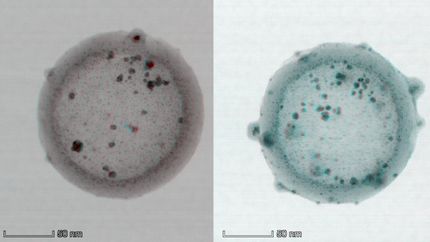Team harnesses intense X-ray beam, observes unusual phenomenon for the first time
Using an enormous X-ray laser - one of only two such machines on Earth - University of Nebraska-Lincoln physicist Matthias Fuchs and scientists from around the world beat formidable odds to observe one of the most fundamental interactions between X-rays and matter.
The findings can aid future studies and may lead to novel new ways to diagnose matter in the future.
Fuchs and his colleagues induced two X-ray photons to simultaneously collide with a single atom, which converts them into a single higher-energetic X-ray photon. It's a phenomenon that doesn't occur under normal circumstances, and the results of the first-ever experiment were published in Nature Physics.
Fuchs, an assistant professor of physics and astronomy, is the article's lead author. Others involved are from the Stanford Linear Accelerator Center, Stanford University and Bar-Ilan University in Israel.
"The experiment was the very first investigation of this kind, which means that we were entering what you would call 'Neuland'," Fuchs said.
Scientists first observed a similar process involving high-intensity visible light in the 1960s, resulting in a technology used in most laser laboratories and even with many laser pointers available to consumers. However, it had not been possible until recently to observe such interactions at X-ray wavelengths because there was no X-ray source that could produce X-rays of sufficient intensity.
Because they have a small wavelength that allows scientists to resolve matter down to the size of its constituent atoms, X-rays are routinely used to take a "deep look" into matter, Fuchs said.
Fuchs and other team members used a new source of X-rays, an X-ray free-electron laser at the National Accelerator Laboratory in California, to conduct experiments.
Focusing the machine's full output into a spot of only 100 nanometers in size, the team generated an X-ray beam with intensity equivalent to all of the sun's radiation that is striking the Earth's surface but concentrated in an area with the diameter of a human hair.
"We needed such extreme intensities to improve the chances of both of the two photons meeting up at exactly the right place and exactly the right time on one of the many atoms that were illuminated," Fuchs said. "Even so, the probability that this nonlinear interaction occurs on any given atom is less than winning the lottery."
The scientists found some unexpected results, however. The energy of the converted photons was much lower than expected, indicating that the physics of the interaction may be richer and more interesting than anticipated.
Most read news
Other news from the department science

Get the analytics and lab tech industry in your inbox
From now on, don't miss a thing: Our newsletter for analytics and lab technology brings you up to date every Tuesday. The latest industry news, product highlights and innovations - compact and easy to understand in your inbox. Researched by us so you don't have to.





![[Fe]-hydrogenase catalysis visualized using para-hydrogen-enhanced nuclear magnetic resonance spectroscopy](https://img.chemie.de/Portal/News/675fd46b9b54f_sBuG8s4sS.png?tr=w-712,h-534,cm-extract,x-0,y-16:n-xl)



















































